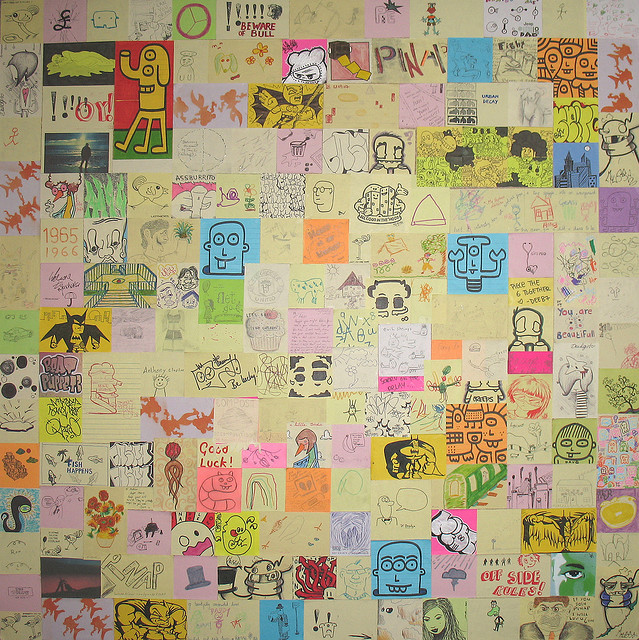People create for a thousand highly individualized reasons. They desire self-expression, an emotional release, or maybe some monetary reward. But beyond the desire to create something, what are the necessary conditions for creativity? How can we consciously create and foster those conditions?
The following article isn’t an exhaustive summary, but I think it works something like this: once your basic needs are met, you must develop the necessary mindset, receive quality input, and have a place to work.
Needs
Here’s a popular image: the creative type who struggles to keep food on their table…if they own a table. They sleep on a different couch every night, live in a whirlwind of turbulent relationships, and still manage to produce great art.
Circumstances like this make fascinating historical anecdotes or smashing marketing copy, perpetuated by a salivating press starved for stories. The un-stated assumption is this: they created their amazing work because of their rotten circumstances.
I call bullshit.
Maybe these are the necessary conditions for a few psychos on the lunatic fringe, but the vast majority of us need a roof over our heads, food in our bellies, and stable relationships with the people around us.
Let’s be honest with ourselves: creating art is, for the most part, a middle-class and up pastime. Most people in the world are understandably more concerned with the basic necessities of life.
So, if you’re reading this, you probably have the basics covered: food, shelter, water, security. You have an internet connection. You may even have a job. Don’t think for a minute you need to live out of your car to write a damn good novel. To believe you need chaos to create is just another (potentially self-destructive) way to procrastinate and avoid work.
At the same time, unmet higher-level needs may be a motivator to create great art.
Mindset
To create the conditions for creativity, you need to find flow. Flow and creativity are like peanut butter and jelly. Time disappears, the Self fades into the background, and good things happen. Flow occurs when a person has “a good balance between the perceived challenges of the task at hand and his or her own perceived skills. One must have confidence that he or she is capable to do the task at hand” (Wikipedia).
To achieve flow, then, you must have a combination of high skill and high confidence. How can you simultaneously build your skills and confidence? The same way you get to Carnegie Hall: practice your ass off, and know that you have a right to create amazing things. Everything in the world that is amazing resulted from its creator investing years of practice to build their skills, often in the face of great self-doubt and external pressures.
Besides building your skills and developing confidence, you usually need a clear idea of what you want to create, as well as a way to get some feedback on your work. Some activities have built-in feedback (competitive sports and video games, for example). However, for most of us, interpreting feedback is a balancing act between closely scrutinizing our own work while keeping our inner critic from running amok. (Read more about How to Manage Your Inner Critic)
Input
You’ve heard the phrase ‘garbage in, garbage out.’ I believe that sensory input and creative output may be similar. In a way, the stuff we create is a remix of years and years of integrated sensory and cognitive information. Our outputs are a mashup of our inputs. If you’re going to put your own mashup out there, at least draw from excellent sources.
I’m not saying you should be plagiarizing or stealing work. That’s ridiculous and reactionary. Instead, I’m saying that great works inspire, enlighten, and improve us. Most of all, great works shape us into who we are, and who we are determines what we create.
How much stimulating sensory information do you receive on a daily basis? Are the things you experience a cause for excitement or stimulation?If not, seek out fascinating and challenging works of all types: art, music, literature, film, even award-winning television shows. Talk to everyone you can and hear what they have to say.
Listen. To people. To music. To the wind rustling the willows.
Workspace
Now that I’ve hit on some marginally esoteric points, I’ll conclude with something decidedly mundane but excessively helpful: your workspace, the physical environment in which you create stuff.
I won’t say you need a clean, minimalist work space, a corner office in Manhattan, or a dugout under a coal furnace. Why? Because I don’t know you that well. I don’t know what you like. All this stuff is personal preference. If you do your best work in a dirty coal hole, who am I to stop you?
However, I will say that you need a workspace of your own. You need a place you can think, a place you can escape distractions, a place that’s conducive to work but not soulless. Inviting but not snooze-inducing. A flat surface with room to move things around. For me, this means a reasonably tidy desk, good tunes, a comfortable chair, and a closed door. Not much but more than enough.
Finally, a caveat: your workspace isn’t your storage area. If you have to move a bunch of shit to do anything, then you probably won’t do anything. You can check out this post on Removing Physical Barriers, or I can give you the summary: the less resistance you have to starting your work, the more likely you are to start.
Over to You
I want to hear what you think about this topic. What are your necessary conditions for creativity? What gets you going? What slams you to a dead stop?
Photo credit: adrian_wallett
If you enjoyed this fine post, please subscribe to Happenchance or follow me on twitter!


Comments on this entry are closed.